Mandatory safety signs are an essential component of workplace and public safety. They provide clear instructions to ensure the well-being of individuals in various environments. These signs, characterized by their blue circular background and white pictograms, are designed to inform people about specific actions that must be followed to prevent accidents and promote safety.
Mandatory signs foster awareness and compliance, whether for wearing personal protective equipment, maintaining hygiene, or following proper operational procedures.
This blog comprehensively categorizes over 60 mandatory safety signs, highlighting their features, significance, and applications across diverse settings to enhance safety standards.
What Are Mandatory Signs?
Mandatory signs are safety indicators that specify required actions or behaviors to ensure safety and compliance in various environments, such as workplaces and public areas. They are typically characterized by a blue circular background with a white pictogram illustrating the required action. These signs are designed to be easily recognizable and universally understood, promoting adherence to safety protocols.
Key Features of Mandatory Signs:
- Shape and Color: Circular shape with a blue background and a white symbol or text.
- Purpose: Indicate actions that must be taken, such as wearing personal protective equipment (PPE) or following specific procedures.
- Design Consistency: Standardized symbols ensure clarity and uniformity, facilitating quick recognition and understanding across different languages and cultures.
60+ Common Mandatory Signs and Their Meanings
Mandatory signs are essential safety indicators that prescribe specific actions to ensure personal and workplace safety. Typically characterized by a blue circular background with a white pictogram, these signs are universally recognized and comply with international standards such as ISO 7010. Lets discuss the common mandatory signs and their meanings:
General Safety Instructions
Safety signs are essential for promoting awareness and ensuring compliance with mandatory actions in various environments. Each sign has universal symbols and clear instructions to address specific safety needs, reduce risks, and protect individuals in workplaces, public spaces, and hazardous areas.
1. General Mandatory Sign

Indicates that a mandatory action is required in the area. It serves as a generic reminder to follow safety instructions.
Key Features:
- Blue circular background with a white exclamation mark.
- Universally understood as “Pay attention to mandatory safety instructions.”
2. Refer to the Instruction Manual/Booklet Sign

Directs individuals to consult the instruction manual or safety booklet before operating equipment or performing tasks.
Key Features:
- Symbol of a booklet or manual.
- Emphasizes the need for informed actions.
- Promotes safety by ensuring adherence to proper procedures.
3. Keep Distance Sign
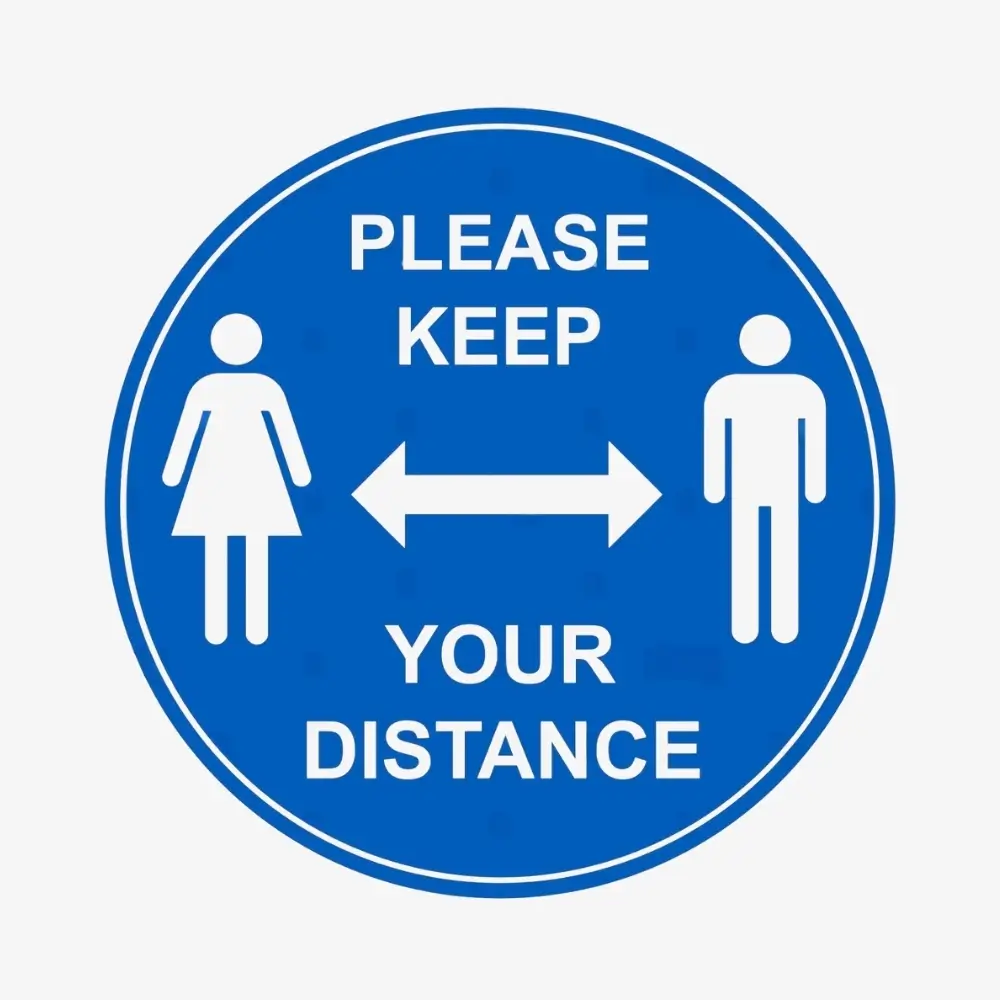
Instructs individuals to maintain a safe physical distance to avoid hazards, collisions, or contamination.
Key Features:
- Symbol depicting two figures with an arrow between them.
- Commonly used in workplaces, machinery zones, and public spaces.
- Enhances safety by reducing risks of accidents or disease transmission.
4. Keep Out of Reach of Children Sign
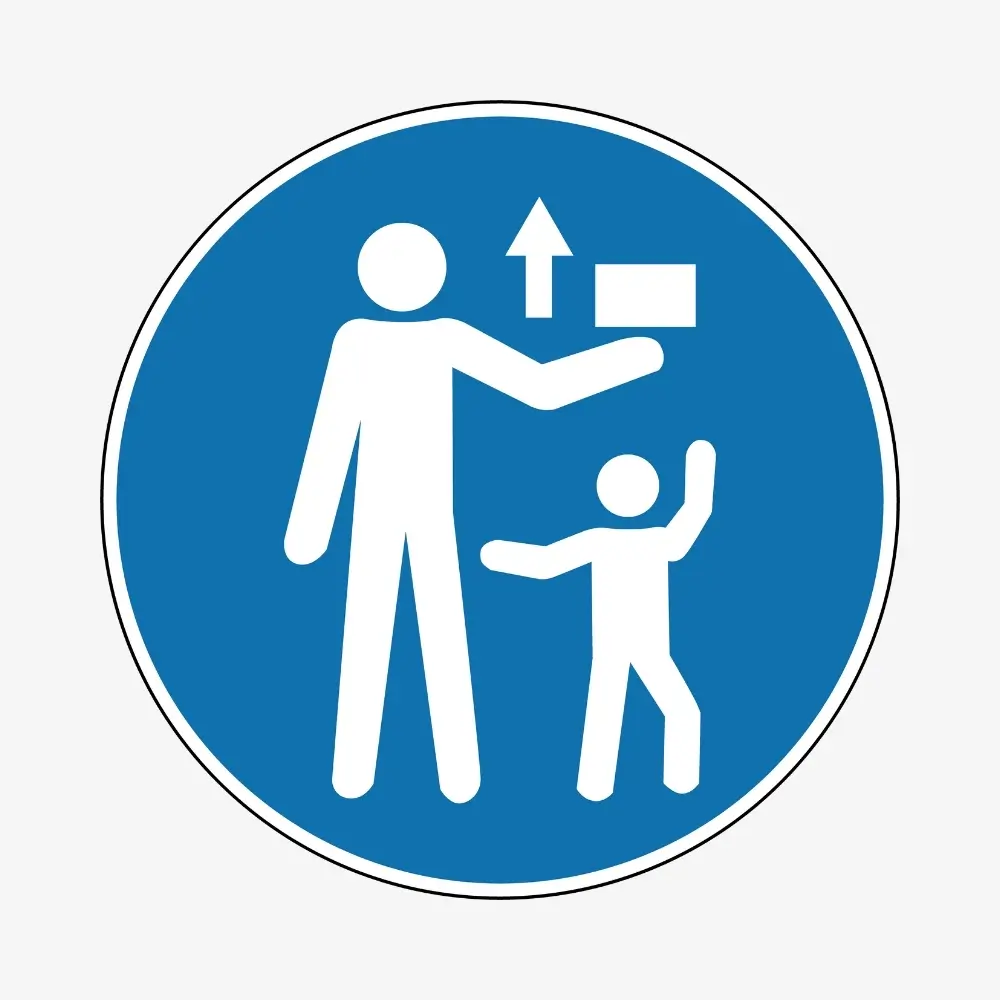
Advises that the area or items must be kept inaccessible to children to prevent harm.
Key Features:
- Symbol of a child reaching toward an item with a prohibitive action.
- Common in chemical storage, hazardous materials, or fragile areas.
- Ensures child safety by restricting access.
5. Keep Children Under Supervision in the Aquatic Environment Sign
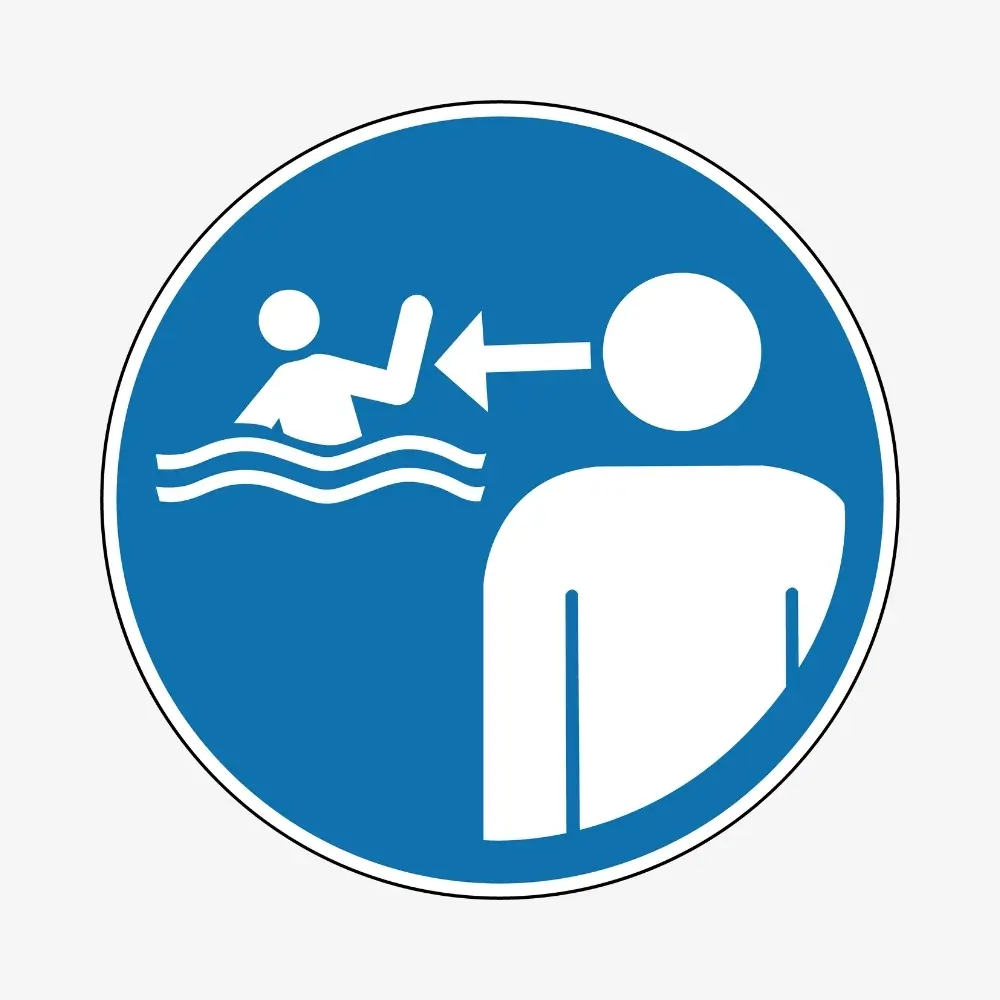
Indicates that children in aquatic settings must always be monitored by a responsible adult.
Key Features:
- Symbol of a child with water waves and an adult figure nearby.
- Promotes child safety in pools, beaches, and water parks.
- Prevents drowning or water-related accidents.
6. Ventilate Before and During Entering Sign
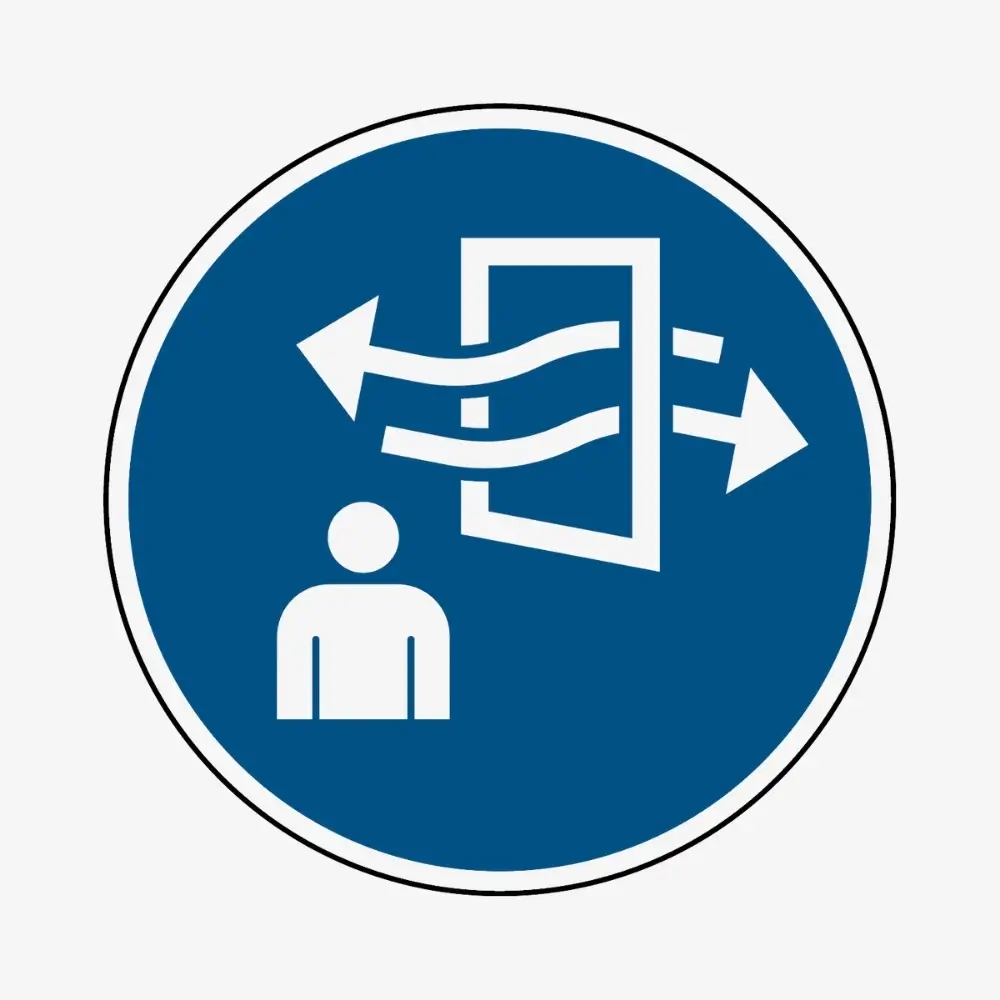
Specifies that proper ventilation is required before and during entry to ensure air quality and safety in confined spaces.
Key Features:
- Symbol of airflow or ventilation fans.
- Used in hazardous environments like chemical storage areas or mines.
- Reduces risks of suffocation or toxic exposure.
7. Ensure Continuous Ventilation Sign

Mandates that continuous ventilation must be maintained to ensure safe air circulation in a specific area.
Key Features:
- Icon showing airflow symbols in a repetitive pattern.
- Common in factories, kitchens, and laboratories.
- Prevents buildup of toxic fumes or pollutants.
8. Entry Only with Supervisor Outside Sign

Indicates that entry is permitted only if a supervisor is present outside to monitor the activity.
Key Features:
- Symbol of a person inside and another person monitoring outside.
- Used in high-risk areas like confined spaces or hazardous sites.
- Enhances accountability and ensures emergency readiness.
9. Check Guard Sign
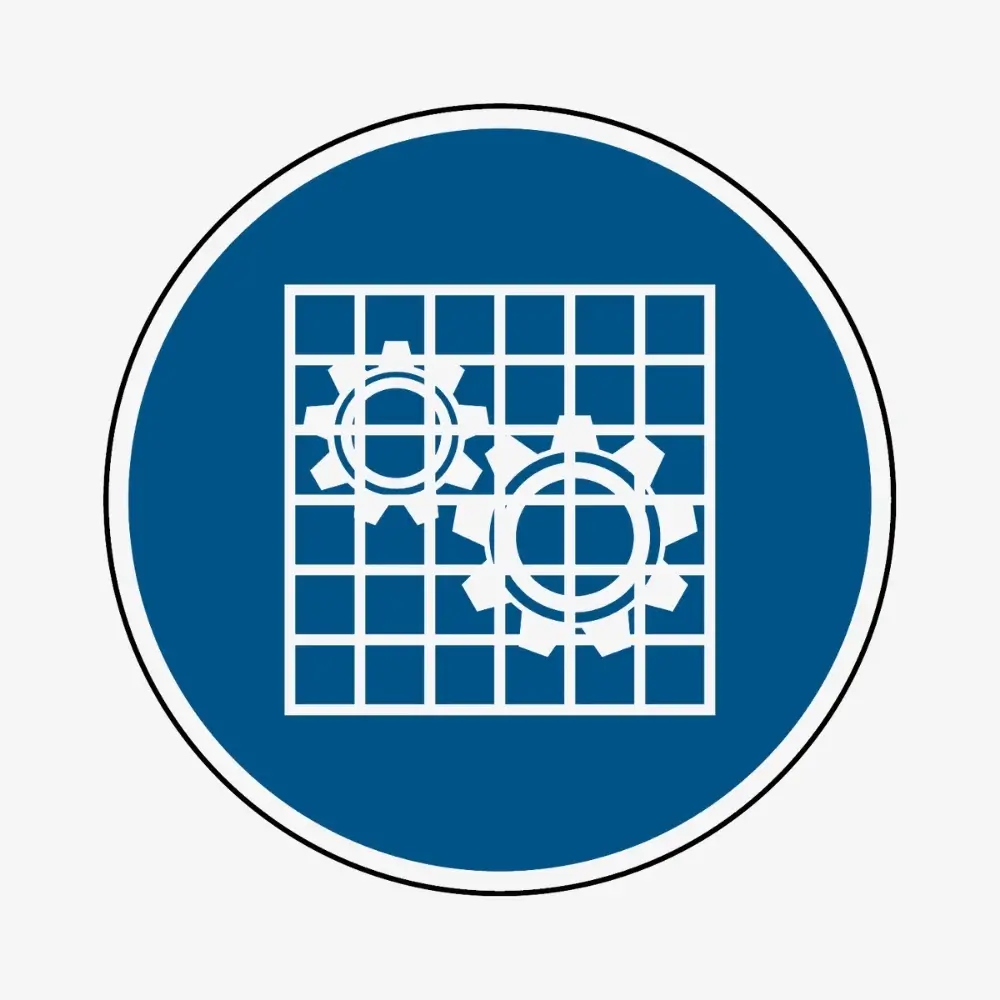
Instructs individuals to verify the presence and condition of guards on machinery or equipment before operation.
Key Features:
- Symbol of a guard or shield icon.
- Ensures machinery is safe to use.
- Reduces risk of injury caused by exposed moving parts.
10. Keep Locked Sign

Specifies that certain equipment, areas, or containers must remain locked when not in use.
Key Features:
- Padlock icon on the sign.
- Prevents unauthorized access or tampering.
- Common in hazardous or restricted zones.
11. Use Litter Bin Sign
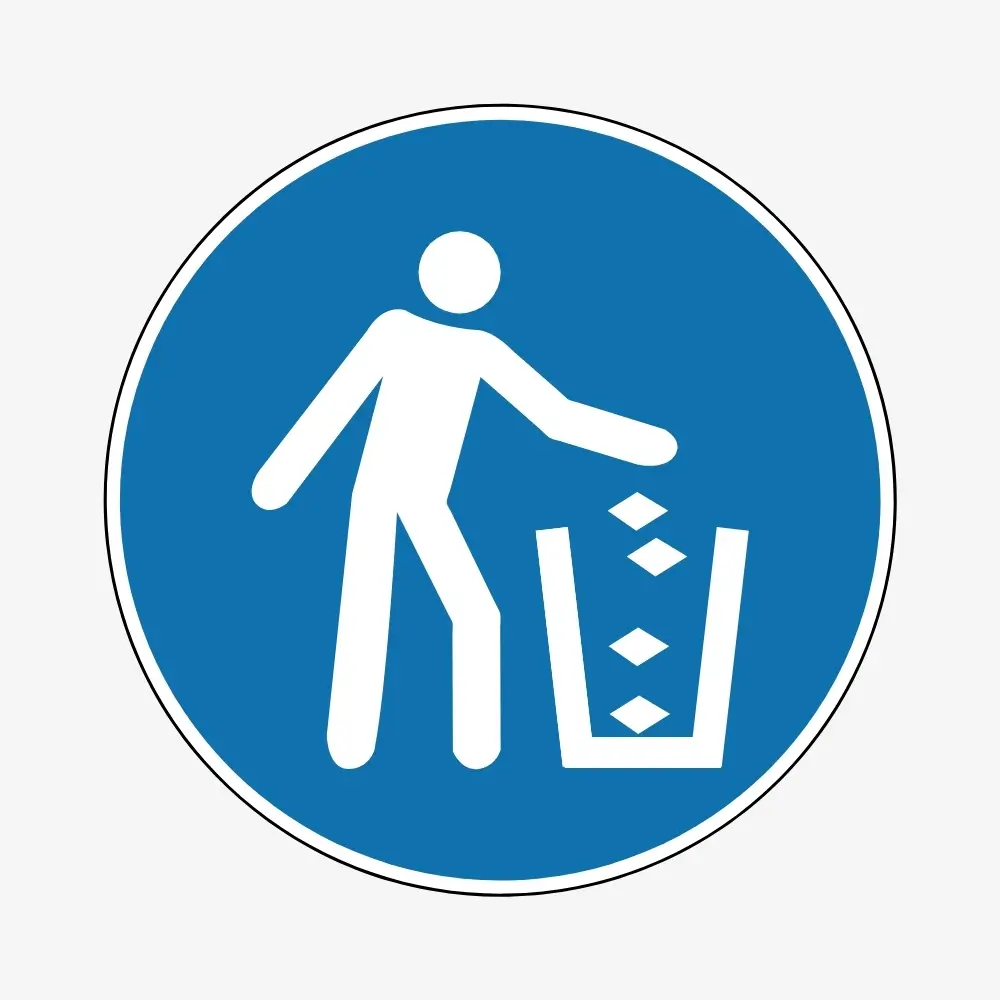
Directs individuals to dispose of waste materials in the provided litter bins to maintain cleanliness.
Key Features:
- Icon of a person throwing trash into a bin.
- Encourages proper waste disposal.
- Common in public spaces, workplaces, and educational institutions.
12. Hold the Trolley Handle Sign

Reminds users to securely hold the handle of a trolley for safe maneuvering.
Key Features:
- Symbol of a hand holding a trolley handle.
- Prevents accidents caused by loss of control.
- Common in warehouses and shopping areas.
13. Disinfect Your Hands Sign

Instruct individuals to disinfect their hands using provided sanitizers or washing stations.
Key Features:
- Icon of hands under a droplet or spray.
- Promotes hygiene and reduces the spread of germs.
- Common in hospitals, laboratories, and public facilities.
14. Disinfect Surface Sign

Specifies that surfaces must be disinfected regularly to maintain cleanliness and prevent contamination.
Key Features:
- Symbol of a hand or spray disinfecting a surface.
- Common in healthcare, food preparation, and public spaces.
- Ensures compliance with hygiene protocols.
Each sign is designed to cater to specific safety needs while ensuring universal understanding and compliance. Let me know if you want any further elaboration or examples!
Personal Protective Equipment (PPE)
PPE is essential for safeguarding individuals against workplace hazards and providing protection for specific parts of the body. These safety measures include a range of equipment like helmets, gloves, goggles, and respirators designed to minimize exposure to risks. Each item serves a unique purpose, ensuring a safer environment across industries, laboratories, and recreational settings.
1. Wear Ear Protection Sign

Indicates the mandatory use of hearing protection in environments with high noise levels to prevent hearing damage.
Key Features:
- Symbol: Earmuffs or earplugs.
- Used in factories, construction sites, and airports.
- Reduces risks of hearing loss due to prolonged exposure to loud noises.
2. Wear Eye Protection Sign

Mandates the use of safety goggles or glasses to protect eyes from flying particles, chemical splashes, or harmful radiation.
Key Features:
- Symbol: Goggles over a face.
- Used in workshops, laboratories, and manufacturing plants.
- Prevents eye injuries or irritation.
3. Wear Opaque Eye Protection Sign
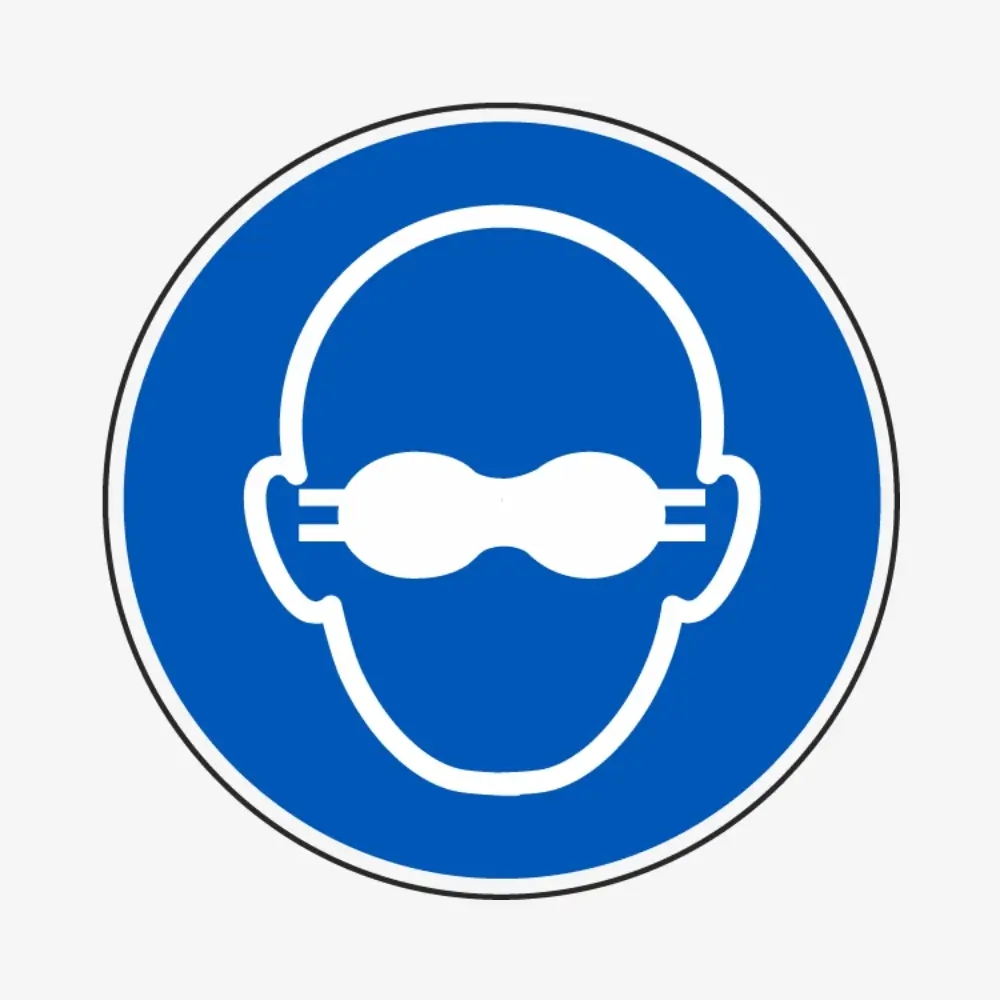
Specifies the use of completely opaque eye protection to safeguard eyes from intense light or specific hazards.
Key Features:
- Symbol: Opaque glasses or shield.
- Common in welding or UV light-related tasks.
- Ensures full shielding of eyes from light exposure.
4. Wear Safety Footwear Sign

Requires wearing sturdy footwear, typically steel-toed or slip-resistant, to protect feet from falling objects or hazardous surfaces.
Key Features:
- Symbol: Boot with a safety icon.
- Common in construction, factories, and warehouses.
- Reduces foot injuries from impacts or punctures.
5. Wear Protective Gloves Sign
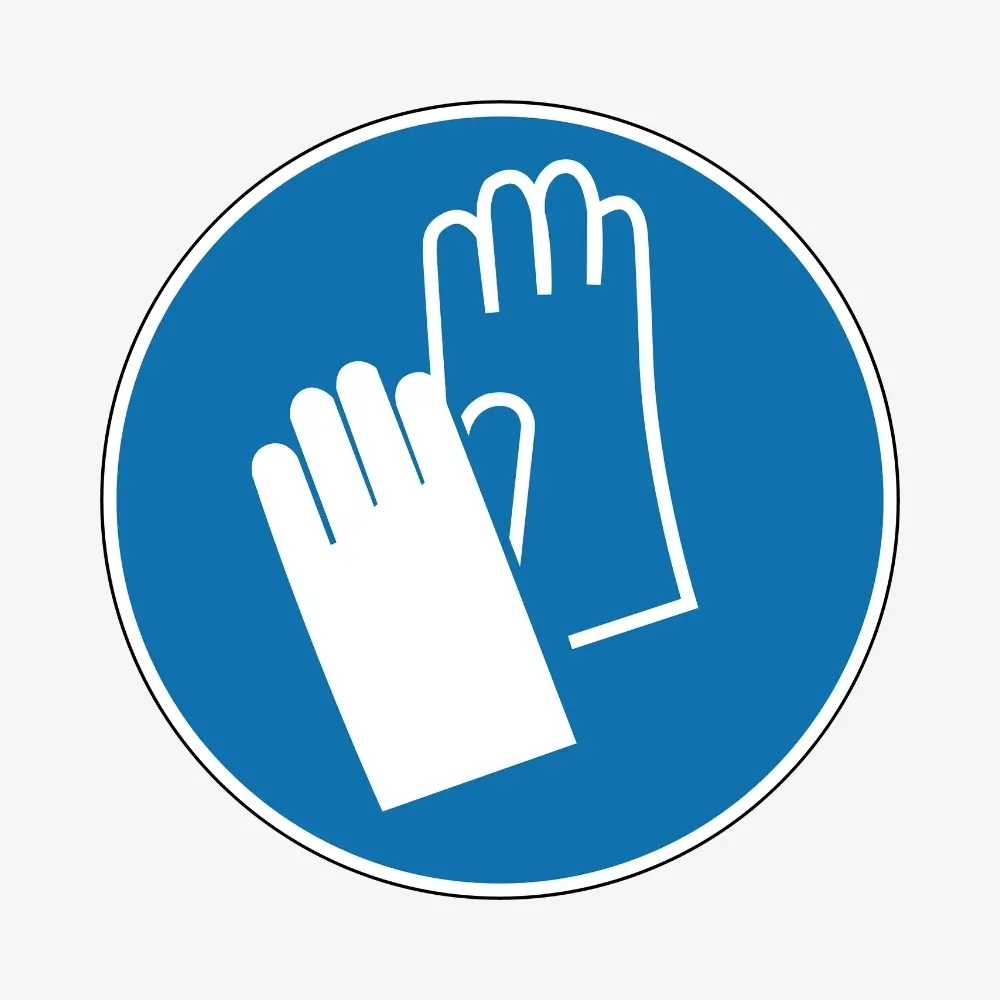
Instructs individuals to wear gloves to protect hands from chemicals, sharp objects, or extreme temperatures.
Key Features:
- Symbol: Gloves on hands.
- Used in laboratories, healthcare, and industrial settings.
- Prevents chemical burns, cuts, or infections.
6. Wear Protective Clothing Sign
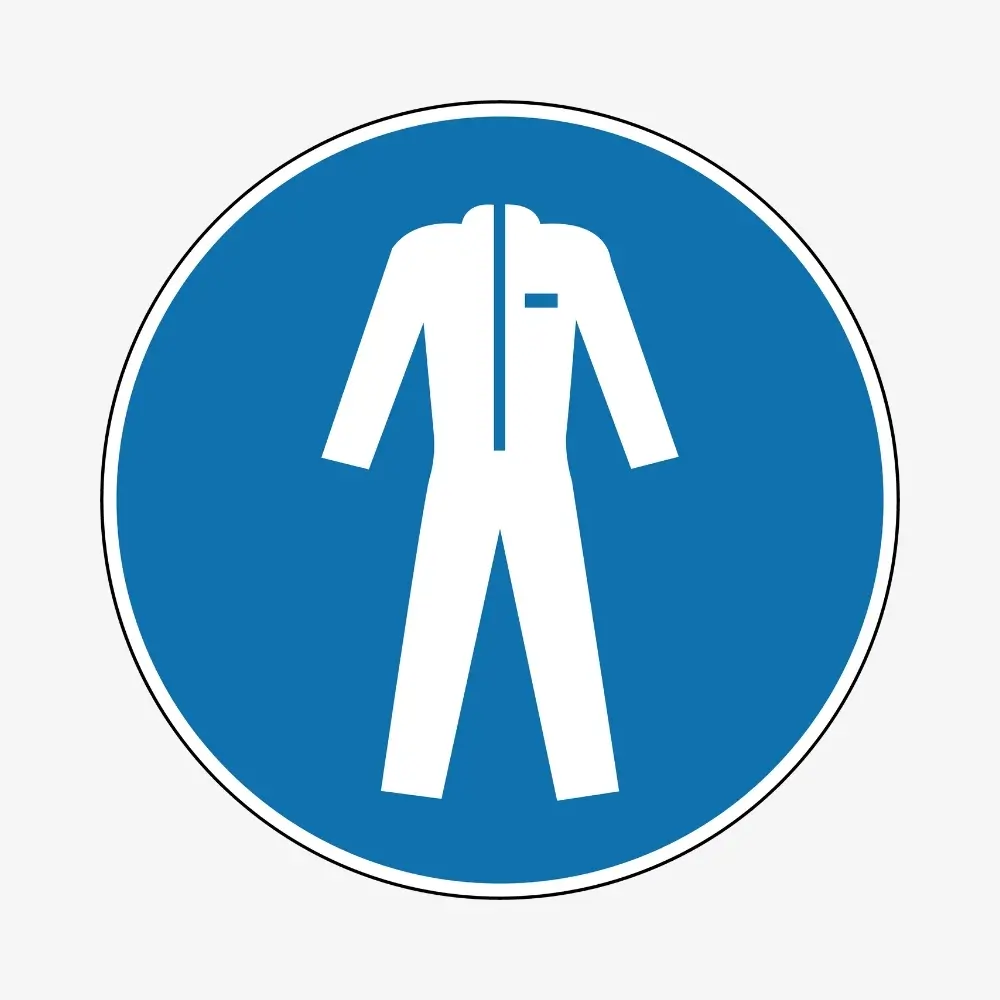
Requires wearing specialized protective clothing to shield the body from hazards like chemicals, fire, or contaminants.
Key Features:
- Symbol: A full-body suit.
- Common in chemical plants, cleanrooms, and welding zones.
- Protects skin and clothing from harm.
7. Wear High Visibility Clothing Sign

Specifies wearing bright, reflective clothing to ensure visibility in low-light or high-risk environments.
Key Features:
- Symbol: Vest with reflective lines.
- Used in roadwork, construction, and outdoor industries.
- Enhances worker visibility for safety.
8. Wear Respiratory Protection Sign
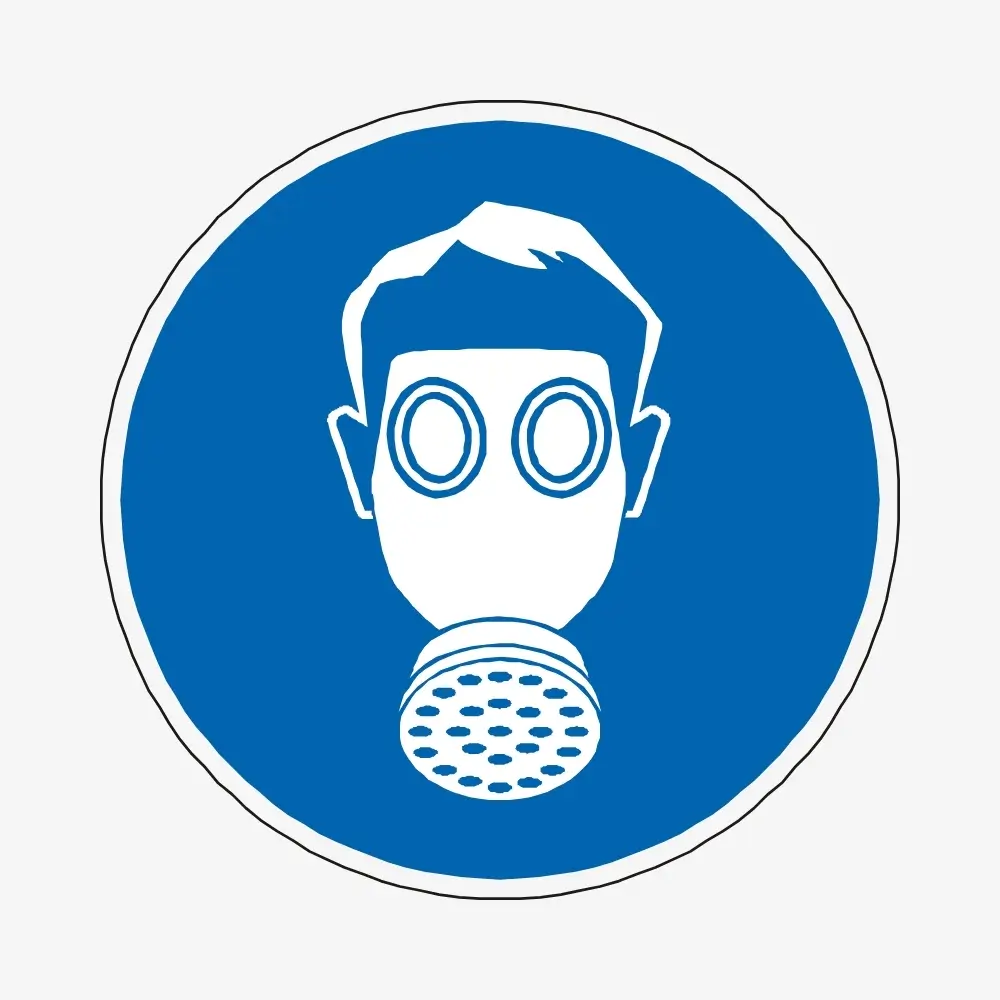
Mandates the use of respirators or masks to protect lungs from harmful fumes, dust, or infectious particles.
Key Features:
- Symbol: Mask covering the nose and mouth.
- Common in dusty, chemical, or infectious environments.
- Prevents respiratory illnesses or poisoning.
9. Wear Safety Harness Sign

Indicates that a safety harness must be worn to prevent falls from height.
Key Features:
- Symbol: Harness strapped to a figure.
- Used in construction, scaffolding, and high-rise maintenance.
- Protects from fall-related injuries.
10. Wear a Welding Mask Sign

It requires the use of a welding helmet or mask to protect the face and eyes from sparks, heat, and UV radiation during welding.
Key Features:
- Symbol: Mask with a welding arc.
- Common in welding workshops and metal fabrication.
- Prevents burns and eye damage.
11. Wear Safety Belts Sign
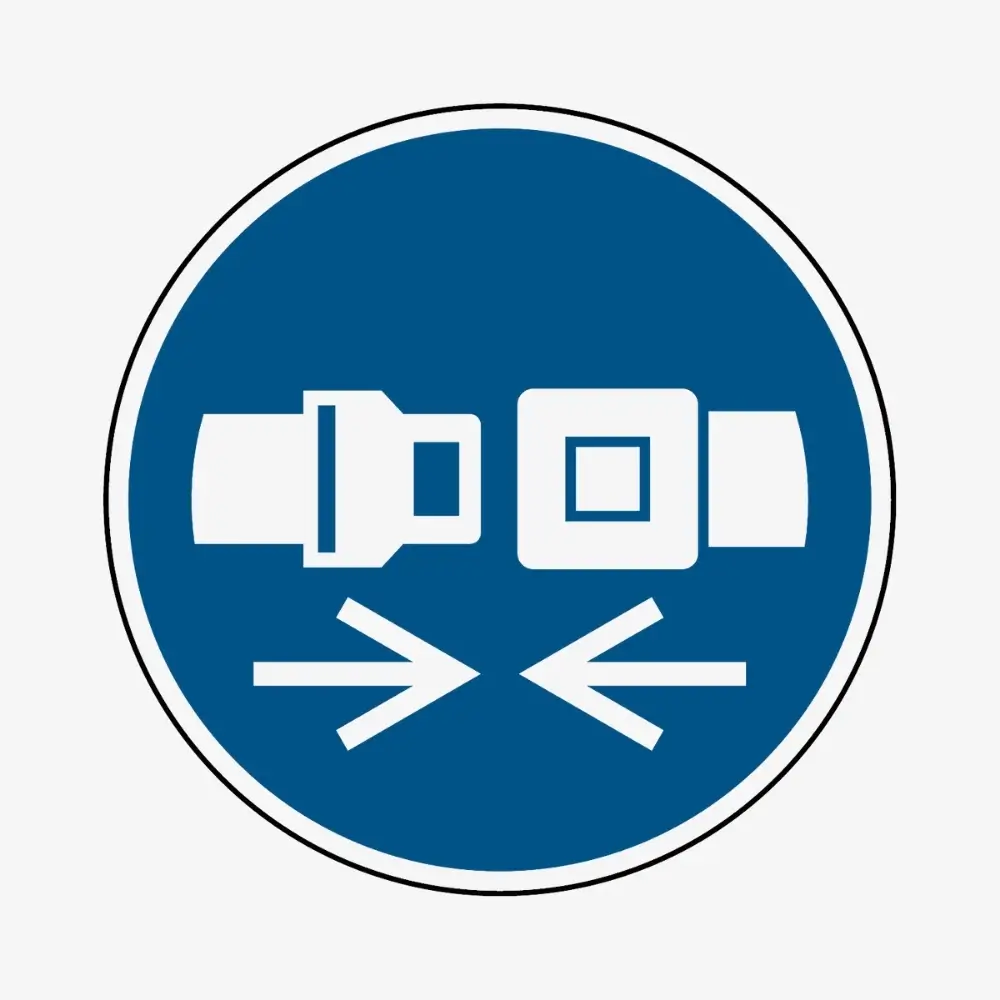
Instructs individuals to wear safety belts for protection while operating certain machinery or vehicles.
Key Features:
- Symbol: Figure wearing a belt.
- Used in forklifts, cranes, and vehicles.
- Prevents injury in case of sudden stops or movements.
12. Wear Face Shield Sign

Mandates wearing a clear shield to protect the face from splashes, particles, or sparks.
Key Features:
- Symbol: Full-face shield.
- Used in laboratories, welding, and grinding.
- Provides complete facial protection.
13. Wear Head Protection Sign
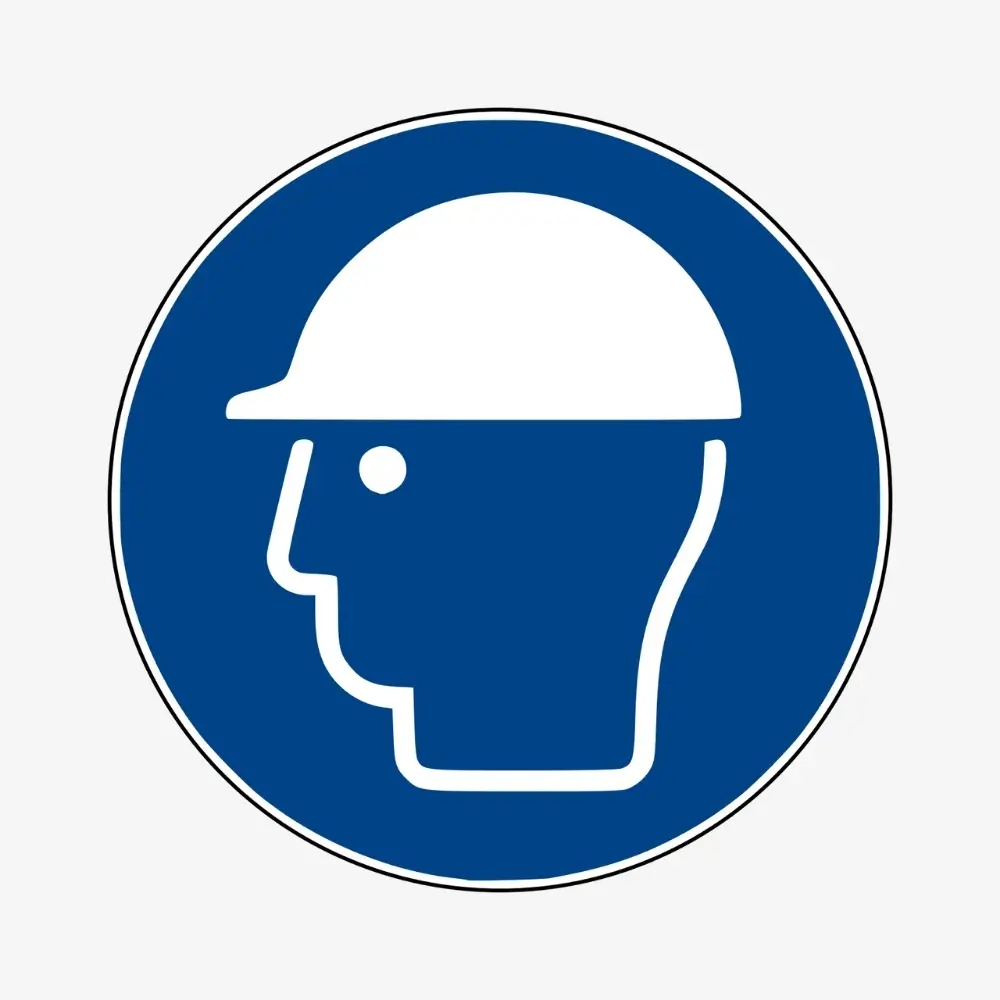
Requires wearing helmets or hard hats to protect the head from falling objects or impacts.
Key Features:
- Symbol: Helmet on a figure.
- Common in construction, mining, and factories.
- Reduces risks of head injuries.
14. Wear a Mask Sign

Specifies wearing a protective mask to prevent the spread of airborne particles or infectious diseases.
Key Features:
- Symbol: Mask over mouth and nose.
- Common in healthcare and public spaces.
- Prevents transmission of diseases and respiratory risks.
15. Wear Protective Roll Sport Equipment Sign
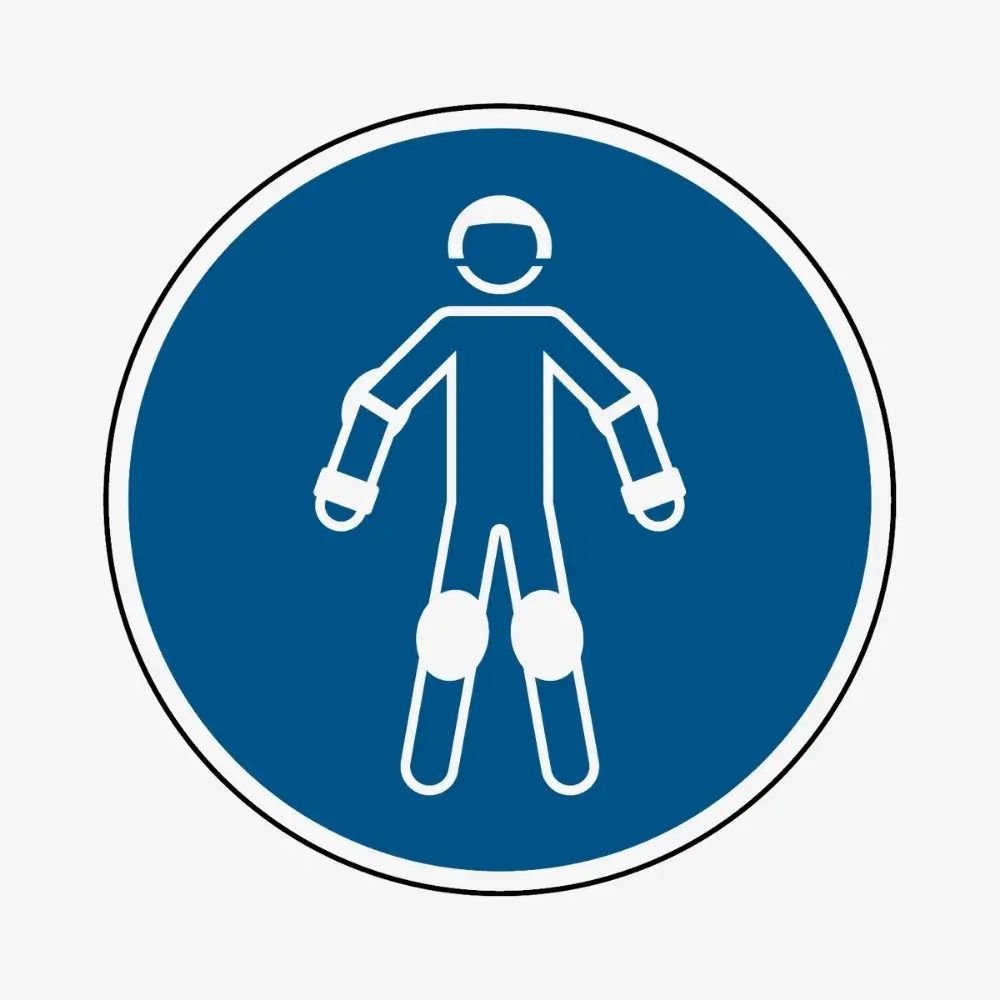
Advises wearing protective gear such as pads and helmets while engaging in roll sports like skating or cycling.
Key Features:
- Symbol: Helmet and pads on a figure.
- Common in recreational or sporting facilities.
- Prevents injuries during falls or collisions.
16. Wear Anti-static Footwear Sign

Instructs the use of footwear designed to dissipate static electricity to prevent sparks in sensitive environments.
Key Features:
- Symbol: Shoe with anti-static symbol.
- Common in electronics manufacturing or flammable areas.
- Reduces static discharge risks.
17. Use Protective Apron Sign
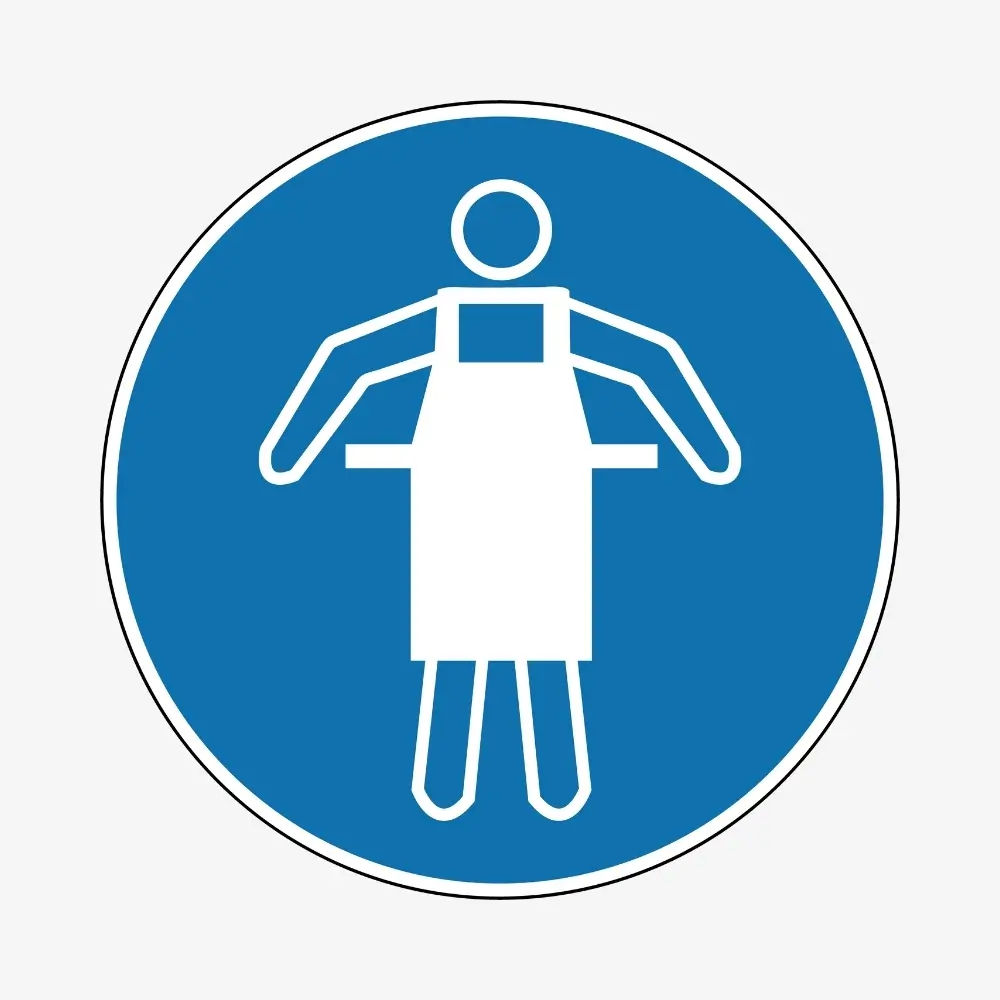
Requires wearing an apron to protect against spills, splashes, or debris.
Key Features:
- Symbol: Apron over a figure.
- Common in kitchens, laboratories, and factories.
- Shields clothing and skin from contaminants.
18. Wear Personal Flotation Devices Sign

Mandates wearing life jackets or buoyancy aids in aquatic environments for safety.
Key Features:
- Symbol: Figure wearing a life jacket.
- Common in boating, swimming, and water sports.
- Prevents drowning incidents.
19. Wear Laboratory Coat Sign

Requires wearing a laboratory coat to protect clothing and skin from spills and splashes.
Key Features:
- Symbol: Lab coat on a figure.
- Common in laboratories and research facilities.
- Ensures hygiene and reduces contamination risks.
Each sign promotes safety in specific environments, ensuring adherence to standard operating procedures. Let me know if you’d like further explanations or visual representations!
Specific Actions
Specific action signs provide clear instructions to ensure safety and proper conduct in various settings. These signs focus on promoting hygiene, preventing accidents, and adhering to best practices for equipment and facility use. By following these directives, individuals contribute to a safer and more efficient environment, reducing risks and enhancing overall safety compliance.
1. Wash Your Hands Sign

Instructs individuals to wash their hands thoroughly to maintain hygiene and prevent the spread of germs.
Key Features:
- Symbol: Hands under running water or with soap.
- Common in hospitals, food preparation areas, and restrooms.
- Promotes hygiene and reduces infection risks.
2. Use Handrail Sign
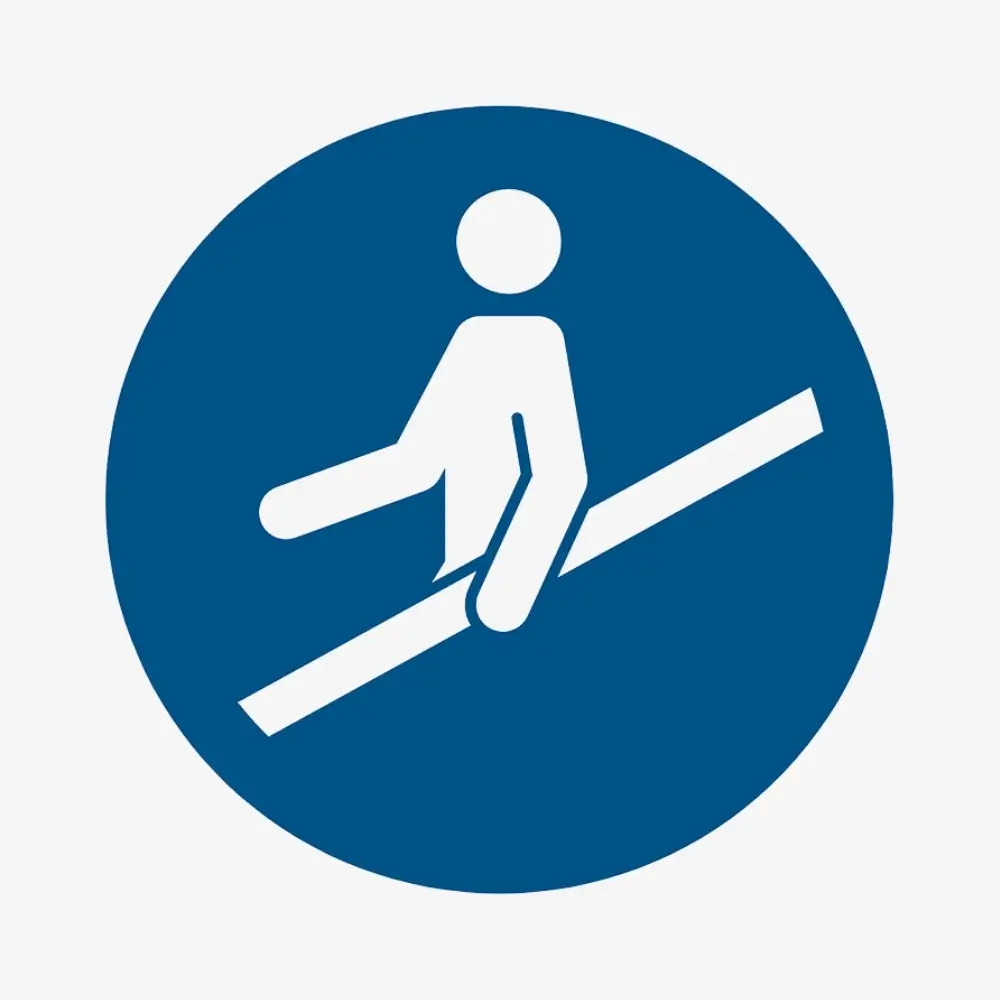
Requires individuals to hold the handrail while using stairs or walkways to prevent falls.
Key Features:
- Symbol: A hand gripping a rail.
- Common in stairways, escalators, and slippery areas.
- Ensures stability and reduces accident risks.
3. Use Barrier Cream Sign

Advises the application of a protective cream to prevent skin irritation or damage in environments involving chemicals or harsh substances.
Key Features:
- Symbol: Hands with a droplet or cream application.
- Used in laboratories, industrial areas, and healthcare settings.
- Shields skin from irritants and allergens.
4. Use Footbridge Sign
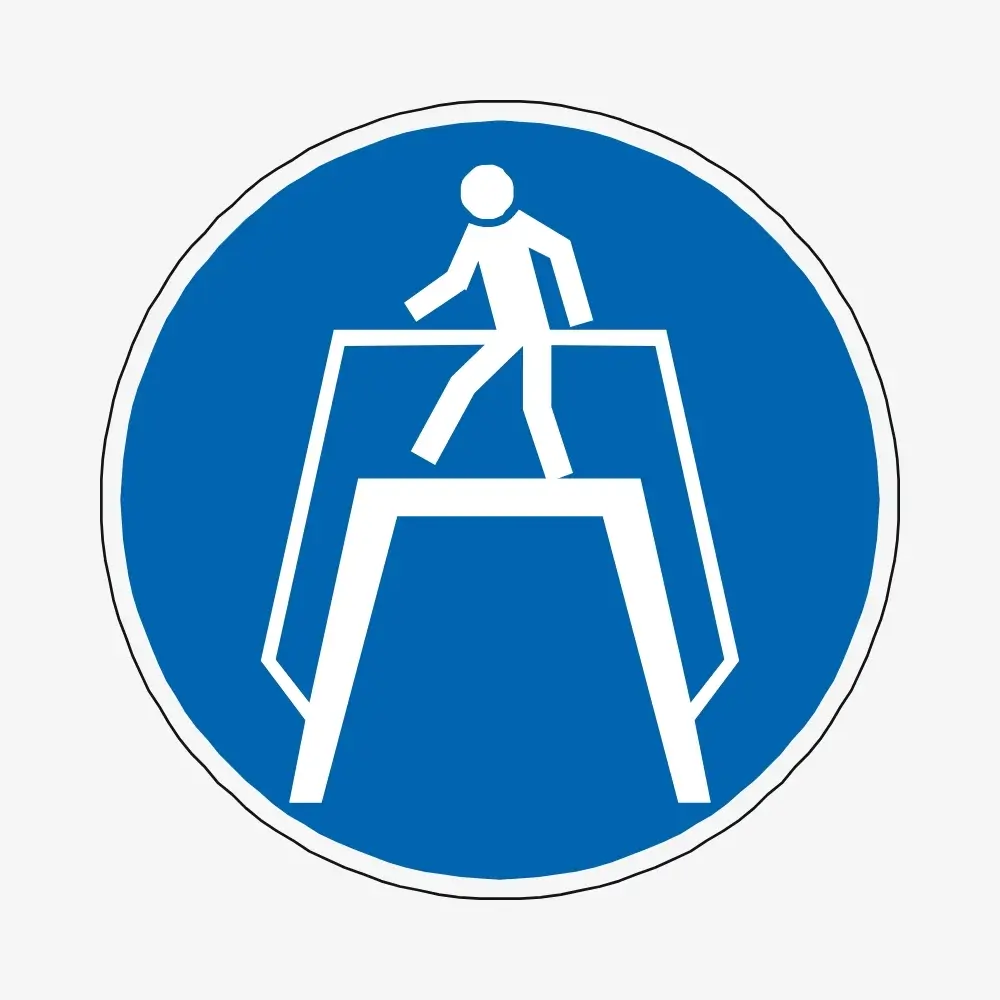
Directs pedestrians to use a designated footbridge to safely cross roads or obstacles.
Key Features:
- Symbol: A person walking on a bridge.
- Common near highways or water crossings.
- Prevents accidents by avoiding hazardous pathways.
5. Use This Walkway Sign

Indicates a designated path for pedestrians to follow for safety.
Key Features:
- Symbol: A person walking on a marked path.
- Common in factories, warehouses, and construction sites.
- Ensures safe separation of pedestrians from vehicular or machinery areas.
6. Connect An Earth Terminal To The Ground Sign
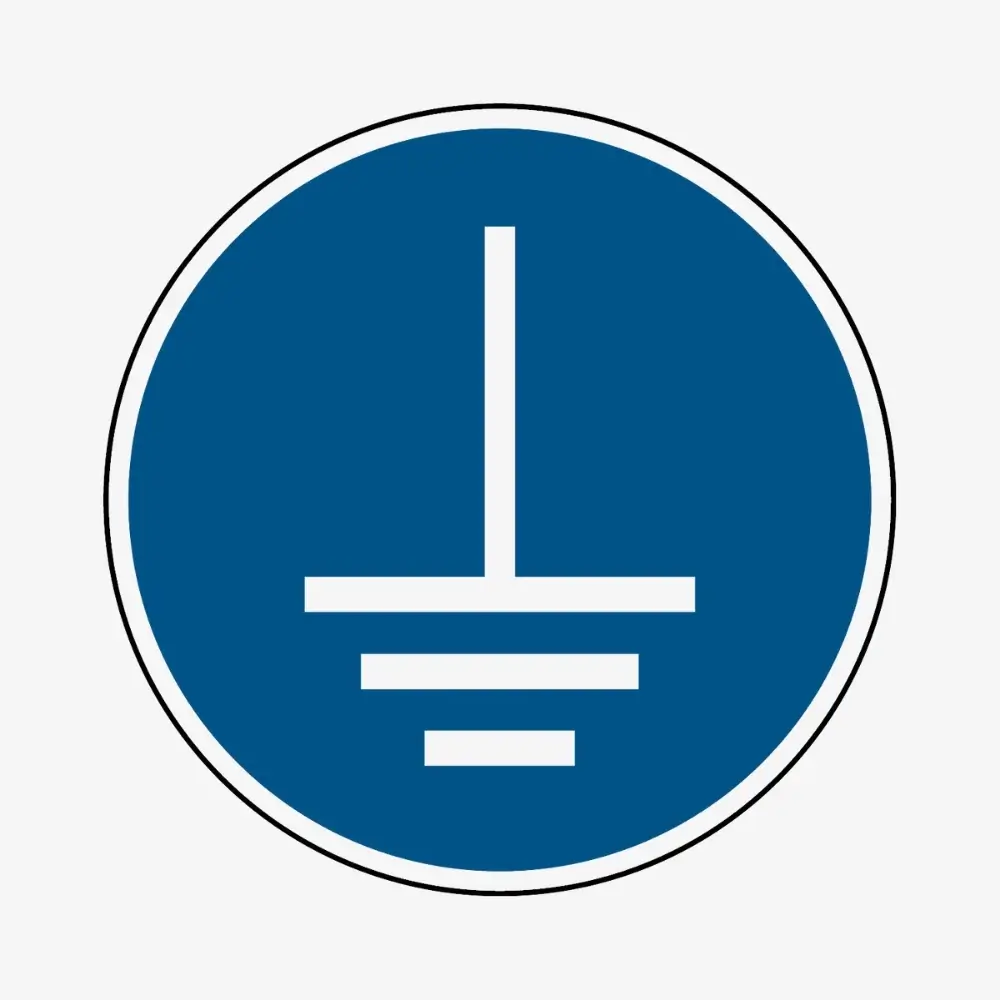
Specifies that electrical equipment must be properly grounded to prevent electrical hazards.
Key Features:
- Symbol: A grounding wire icon.
- Common in electrical installations and industrial settings.
- Prevents shocks and ensures electrical safety.
7. Disconnect the Mains Plug From the Electrical Outlet Sign

Requires unplugging the electrical device from the mains outlet before performing maintenance or repairs.
Key Features:
- Symbol: A plug being removed from a socket.
- Common in workshops and household appliances.
- Prevents electrocution or damage during servicing.
8. Disconnect Before Carrying Out Maintenance Or Repair Sign

Instructs individuals to isolate power sources before starting maintenance work.
Key Features:
- Symbol: A disconnection icon with tools.
- Common in machinery, electronics, and industrial equipment.
- Ensures safety by eliminating risks of accidental power supply.
9. Open the Safety Bar of the Chairlift Sign

Directs individuals to open the safety bar before alighting from a chairlift.
Key Features:
- Symbol: Chairlift with an open bar.
- Common in ski resorts and cable cars.
- Ensures safe and orderly dismounting.
10. Close the Safety Bar of the Chairlift Sign

Mandates closing the safety bar after boarding a chairlift for secure travel.
Key Features:
- Symbol: Chairlift with a closed bar.
- Common in ski resorts and cable cars.
- Prevents falls during travel.
11. Immediately Leave the Tow-track in the Event of Falling Sign

Instructs individuals to leave the tow-track immediately to avoid hazards if they fall.
Key Features:
- Symbol: A figure leaving a tow-track.
- Common in ski slopes and tow paths.
- Reduces risks of collisions or injuries.
12. Lift Ski Tips Sign

Advises skiers to lift their ski tips to avoid entanglement or accidents on slopes or tow-tracks.
Key Features:
- Symbol: Skis pointing upward.
- Common in ski lifts or slopes.
- Prevents equipment damage or falls.
13. Secure Gas Cylinders Sign

Requires proper securing of gas cylinders to prevent tipping, leaks, or explosions.
Key Features:
- Symbol: Cylinder with a secured strap or holder.
- Common in laboratories, factories, and storage areas.
- Ensures safety by preventing accidents involving pressurized gases.
Each sign conveys specific actions required to maintain safety and efficiency in diverse environments. Let me know if you’d like additional details or examples for practical implementation!
Launch Sequence Operations
Launch sequence operations involve critical, step-by-step procedures to ensure safety, efficiency, and readiness during maritime, aerospace, or emergency events. These operations include securing equipment, deploying rescue crafts, and activating essential systems. Each step is vital for maintaining operational safety and achieving successful outcomes during launches or emergency evacuations.
1. Close and Secure Hatches in Launch Sequence Sign
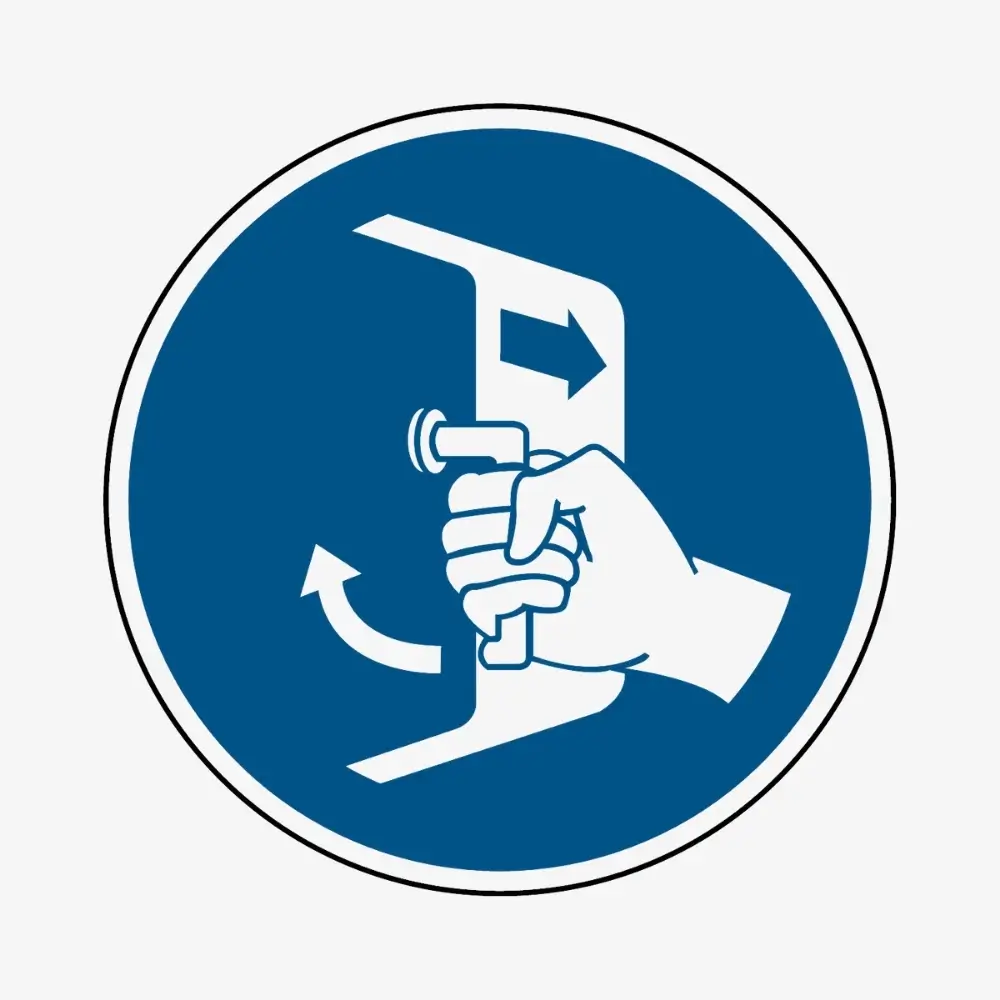
Indicates that hatches must be properly closed and secured as part of the launch preparation sequence to ensure safety and readiness.
Key Features:
- Symbol: A hatch with a closing or locking mechanism.
- Common in ships, submarines, and spacecraft operations.
- Prevents water or air ingress during launch or emergencies.
2. Start Engine in Launch Sequence Sign
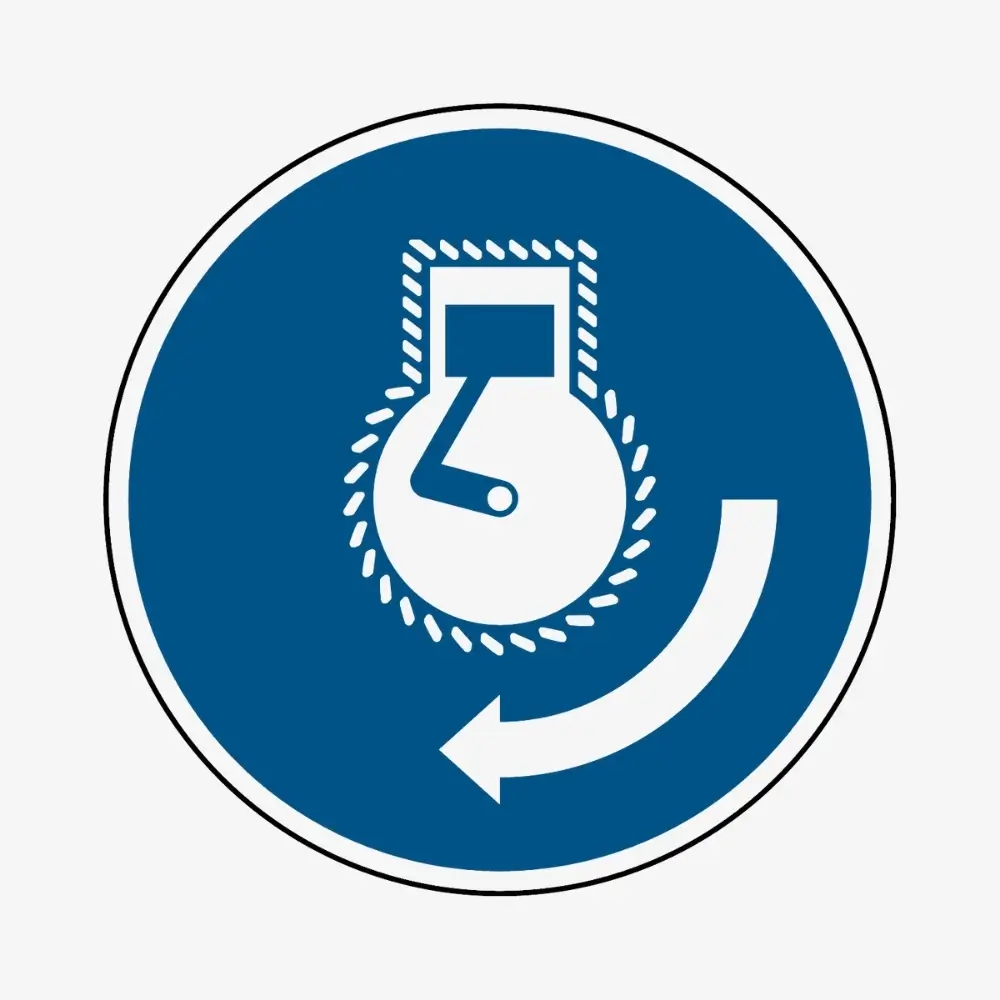
Directs operators to activate the engine as a critical step in the launch sequence.
Key Features:
- Symbol: An engine with an activation symbol (e.g., ignition key or power-on icon).
- Common in maritime, aerospace, or emergency equipment setups.
- Ensures readiness for movement or propulsion.
3. Lower Lifeboat to the Water in the Launch Sequence Sign
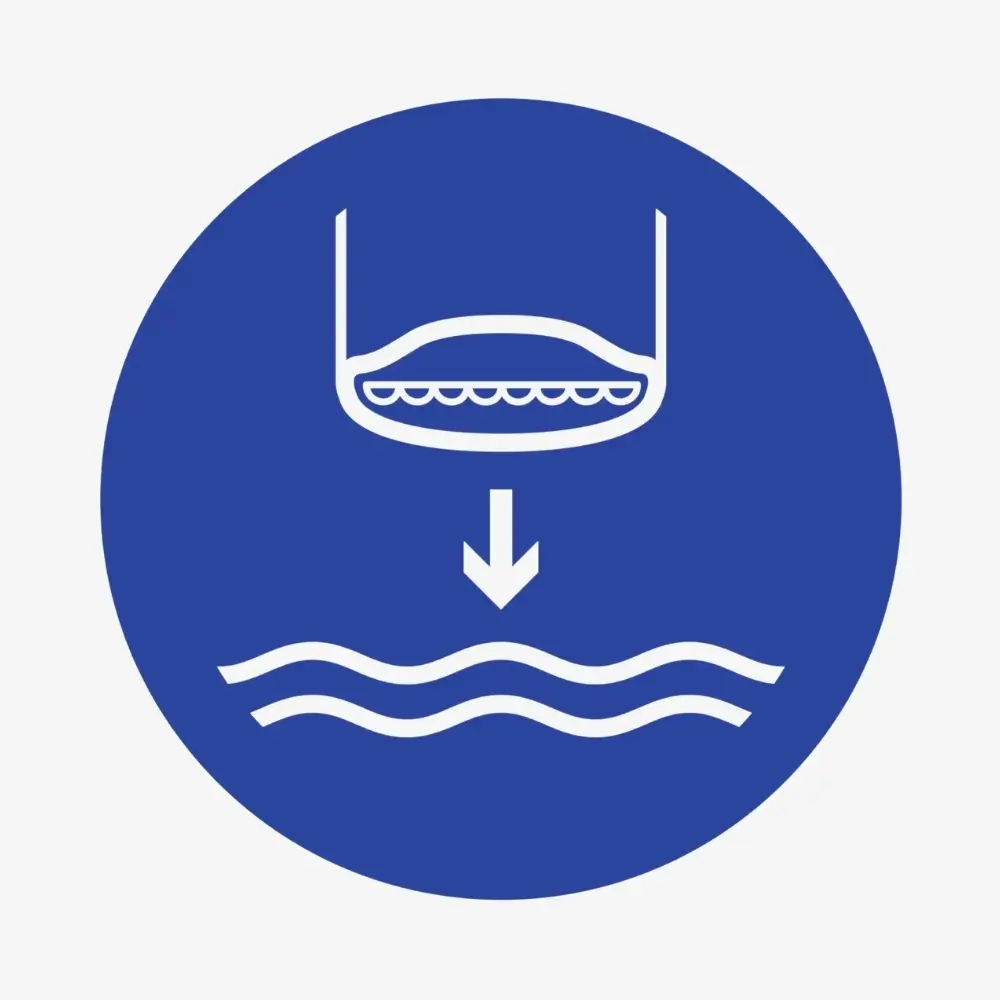
Instructs personnel to deploy the lifeboat into the water during emergencies or as part of a practice launch sequence.
Key Features:
- Symbol: A lifeboat being lowered with cables or davits.
- Common in maritime vessels and emergency drills.
- Ensures safe deployment for rescue operations.
4. Lower Liferaft to the Water in Launch Sequence Sign

Specifies the action of deploying an inflatable liferaft into the water for emergency use.
Key Features:
- Symbol: A liferaft being lowered or inflated.
- Common on ships, offshore rigs, and survival crafts.
- Facilitates swift and safe evacuation during emergencies.
5. Lower the Rescue Boat to the Water in the Launch Sequence Sign

Mandates the lowering of a rescue boat to the water for search, rescue, or emergency purposes.
Key Features:
- Symbol: A rescue boat descending with a lifting mechanism.
- Common in maritime operations and emergency drills.
- Ensures readiness for immediate deployment in rescue missions.
6. Release Falls in Launch Sequence Sign

Instructs operators to release the cable or mechanism holding a lifeboat or similar craft in place after lowering it to the water.
Key Features:
- Symbol: A release mechanism with arrows indicating detachment.
- Used in lifeboat or rescue boat operations.
- Ensures the craft is fully detached and operational in the water.
7. Start Water Spray in Launch Sequence Sign

Indicates the activation of water spray systems, often to cool equipment or reduce fire risks during launch.
Key Features:
- Symbol: Water spray or sprinklers in action.
- Common in aerospace, industrial plants, and ship launches.
- Prevents overheating or fire hazards.
8. Start Air Supply in Launch Sequence Sign
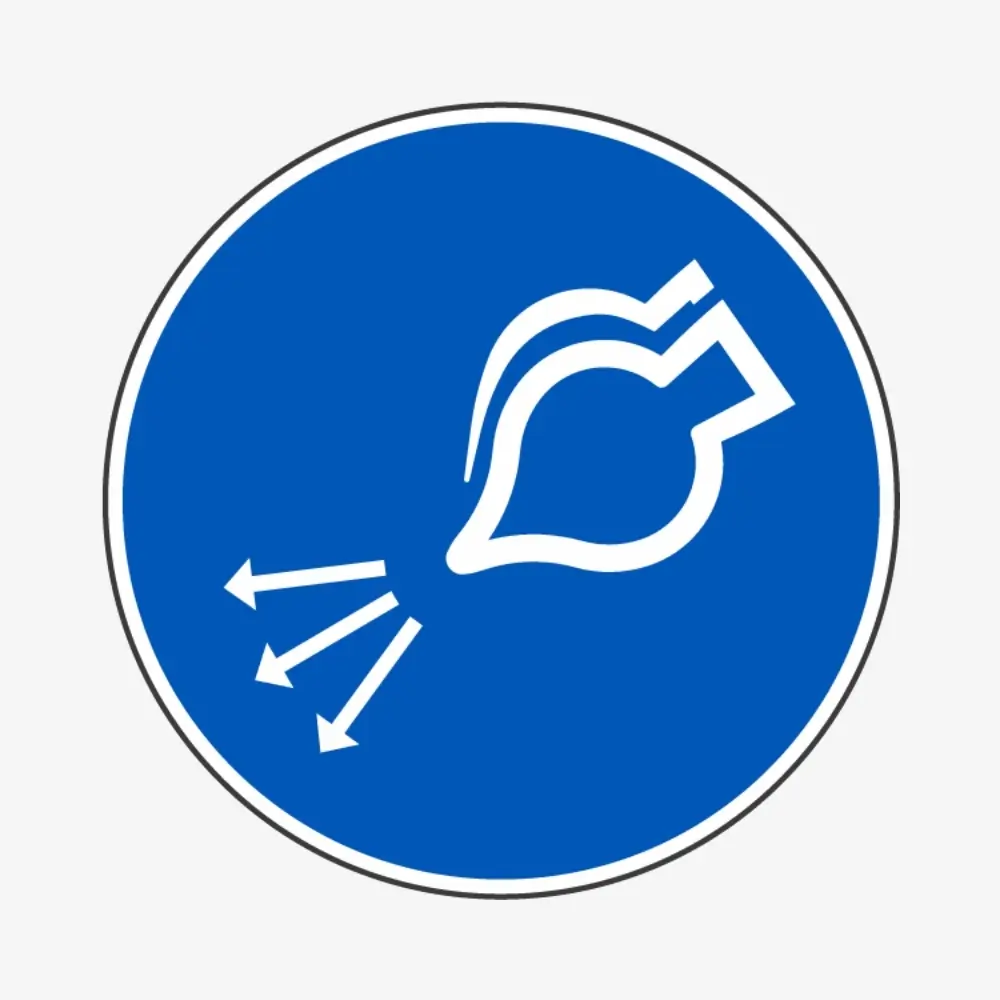
Directs operators to activate the air supply system to maintain breathable air in enclosed spaces or for equipment operation.
Key Features:
- Symbol: Airflow icon, often with pipes or ventilation ducts.
- Common in confined spaces, submarines, and emergency shelters.
- Ensures proper ventilation or pressurization.
9. Release Lifeboat Gripes in Launch Sequence Sign
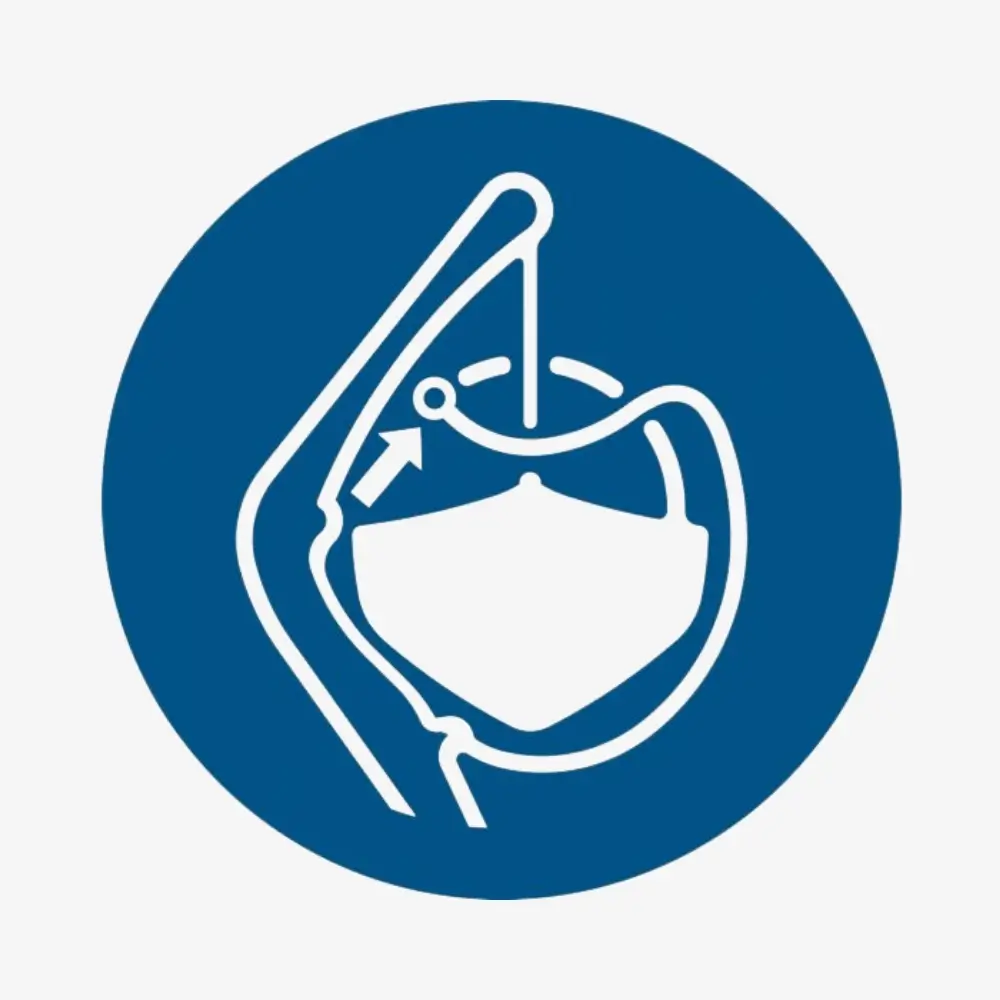
Mandates the removal of lifeboat securing straps or gripes to enable lowering and deployment.
Key Features:
- Symbol: Securing straps being removed or detached.
- Common in lifeboat stations on ships.
- Facilitates the safe and efficient release of lifeboats.
Each of these signs is critical in ensuring the systematic and safe execution of launch procedures in maritime, aerospace, and emergency response operations. Let me know if you’d like additional details or customized representations!
Equipment Use
Equipment use signs provide essential guidance for the safe and efficient operation of tools and machinery. By highlighting critical safety measures and best practices, these signs ensure that equipment is used responsibly, minimizing risks to individuals and the environment. Adherence to these instructions enhances workplace safety and operational efficiency across diverse settings.
1. Use Table Saw, Adjustable Guard Sign

Directs individuals to ensure that the adjustable guard on a table saw is in place and properly positioned before use to prevent injuries.
Key Features:
- Symbol: A table saw with a visible blade guard in position.
- Purpose: Protects hands and body from direct contact with the saw blade.
- Common Uses: Workshops, carpentry, and industrial manufacturing settings.
- Importance: Reduces risks of cuts and debris ejection during saw operation.
2. Use Self-contained Breathing Appliance Sign

Individuals must use a self-contained breathing apparatus (SCBA) in environments with potentially harmful or oxygen-deficient atmospheres.
Key Features:
- Symbol: A person wearing an SCBA mask with an air tank.
- Purpose: Provides breathable air in hazardous environments like confined spaces or areas with toxic gases.
- Common Uses: Firefighting, hazardous material handling, and rescue operations.
- Importance: Prevents suffocation or inhalation of toxic substances.
3. Use a Gas Detector Sign
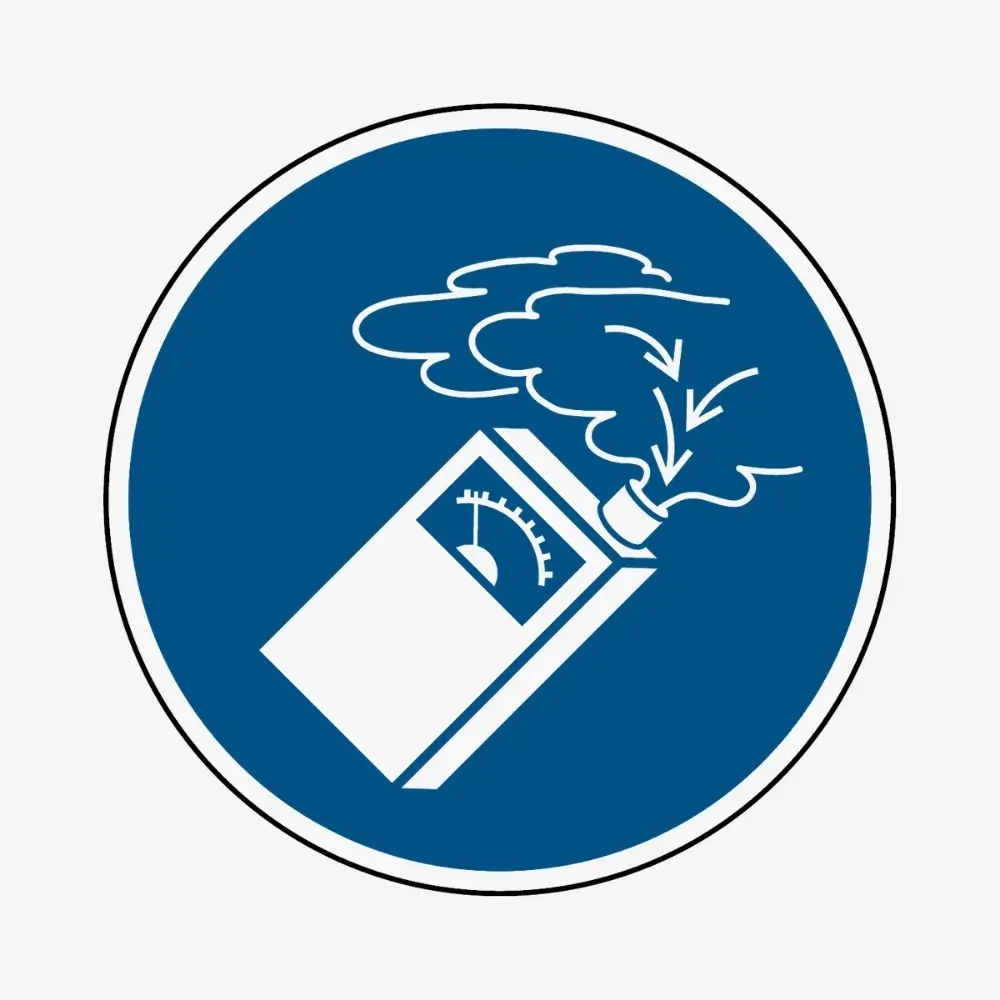
Instruct individuals to use a gas detector to monitor the presence of hazardous or flammable gases in the area.
Key Features:
- Symbol: A handheld gas detector device with an indicator.
- Purpose: Alert users to unsafe gas concentrations for timely action.
- Common Uses: Industrial facilities, laboratories, and underground environments.
- Importance: Prevents gas-related incidents like poisoning, explosions, or suffocation.
4. Sound Horn Sign

Directs operators of vehicles or machinery to sound the horn to warn others of their presence or movement in the area.
Key Features:
- Symbol: A horn or a sound wave icon.
- Purpose: Ensures the safety of pedestrians and workers by providing an audible alert.
- Common Uses: Construction sites, warehouses, and industrial zones.
- Importance: Reduces the risk of collisions and improves situational awareness.
Each sign emphasizes the safe and proper use of specific equipment, ensuring compliance with safety protocols in various operational environments. Let me know if you’d like more detailed descriptions or visual representations!
Special Considerations
Special considerations address unique safety needs in specific environments, activities, or for vulnerable groups. These signs emphasize precise instructions to ensure the safety and well-being of individuals, particularly in scenarios requiring heightened attention or specialized precautions. Following these guidelines minimizes risks and enhances overall safety and order.
1. Infants Must Be Protected With Opaque Eye Protection Sign

Requires infants to wear completely opaque eye protection to shield their eyes from bright light, harmful radiation, or specific hazards during particular activities or procedures.
Key Features:
- Symbol: Infant figure with opaque goggles or eye shield.
- Purpose: Protects infants’ sensitive eyes from damage caused by intense light or environmental conditions.
- Common Uses: Medical procedures, phototherapy, or environments with strong artificial lighting.
- Importance: Prevents vision impairment and ensures infant safety.
2. Alighting From Toboggan to the Left Sign

Instruct individuals using a toboggan to exit safely to the left side after completing their ride.
Key Features:
- Symbol: Figure stepping off a toboggan with an arrow pointing to the left.
- Purpose: Ensures orderly and safe dismounting of the toboggan to avoid collisions or accidents.
- Common Uses: Tobogganing parks, ski slopes, or recreational facilities.
- Importance: Prevents congestion and enhances user safety during activities.
3. Alighting From Toboggan to the Right Sign
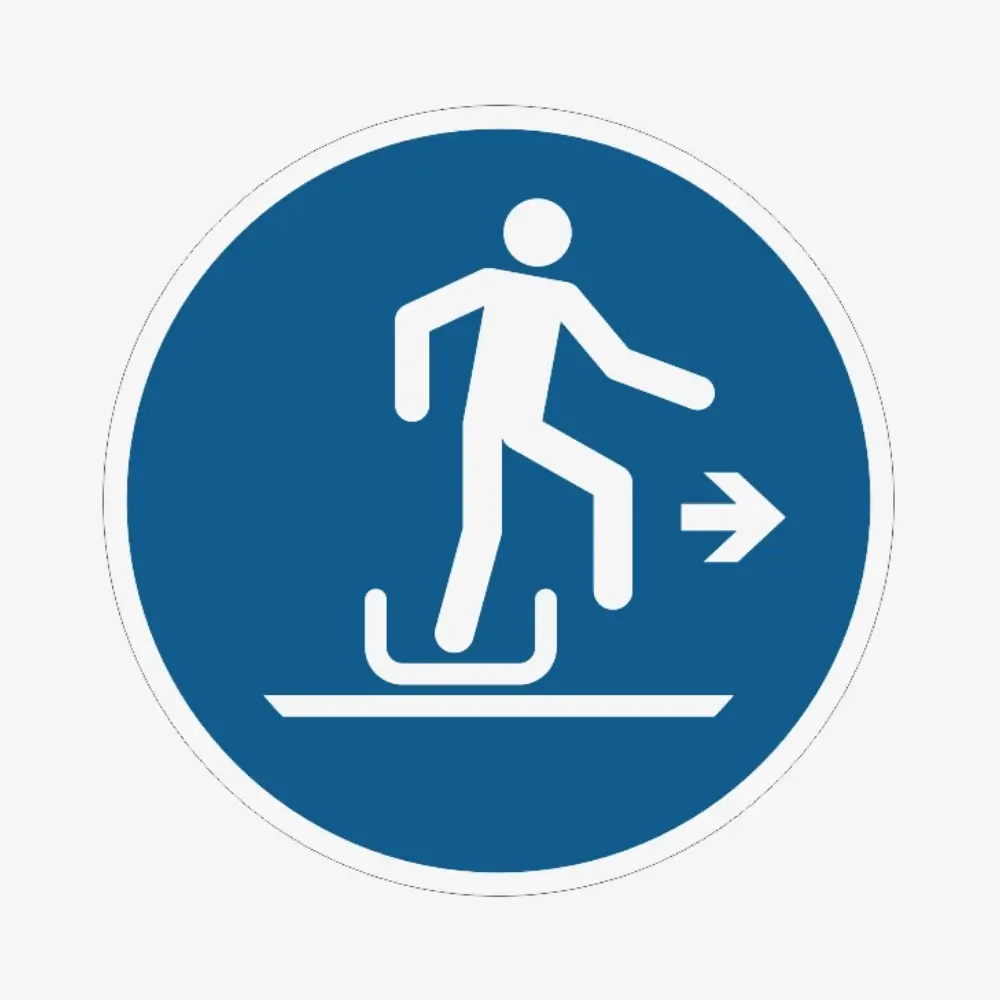
Instruct individuals using a toboggan to exit safely to the right side after completing their ride.
Key Features:
- Symbol: Figure stepping off a toboggan with an arrow pointing to the right.
- Purpose: Directs users for safe dismounting to avoid interference with oncoming riders or obstacles.
- Common Uses: Tobogganing parks, ski slopes, or recreational facilities.
- Importance: Maintains safety protocols and prevents mishaps during high-traffic activity.
Each of these signs caters to specific safety needs, ensuring the well-being of individuals in specialized or recreational environments. Let me know if you’d like additional insights or visual guidelines!
Conclusion
Mandatory safety signs are not just regulatory requirements but vital tools for safeguarding lives and maintaining order in diverse environments. By clearly communicating the actions required to prevent accidents and hazards, these signs create a safety culture, ensuring that individuals and organizations comply with best practices.
Whether it’s in industrial settings, public spaces, or recreational areas, the consistent use of these signs fosters awareness, minimizes risks, and upholds safety standards. As we adapt to evolving challenges, embracing these universally recognized safety symbols will remain a cornerstone of protecting people and promoting responsibility in every sphere.

